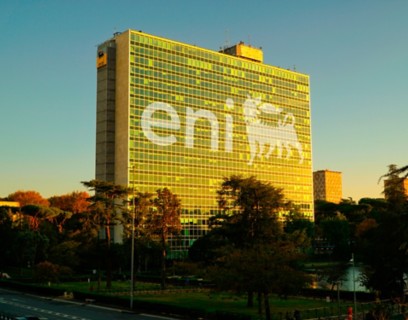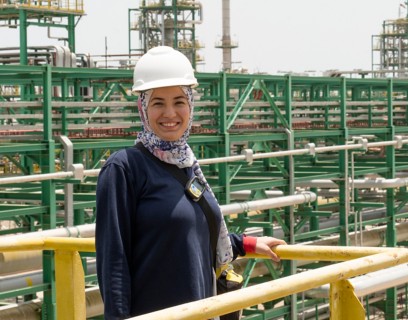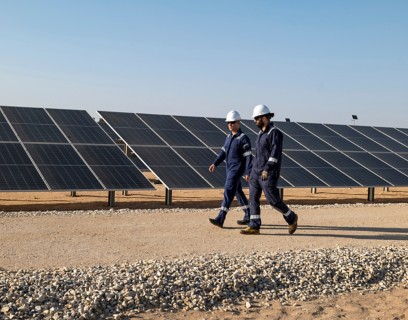Main financial risks
Our approach involves identifying, assessing and managing financial and top risks with respect to the business objectives.

Financial and top risks
Financial risk
Financial risks are managed in respect of the guidelines issued by the Board of Directors of Eni SpA in its role of directing and setting the risk limits, targeting to align and centrally coordinate Group companies’ policies on financial risks (“Guidelines on financial risks management and control”). The “Guidelines” define for each financial risk the key components of the management and control process, such as the target of the risk management, the valuation methodology, the structure of limits, the relationship model and the hedging and mitigation instruments.
Market risk
Market risk is the possibility that changes in currency exchange rates, interest rates or commodity prices will adversely affect the value of the Group’s financial assets, liabilities or expected cash flows. The Company actively manages market risk in accordance with the aforementioned guidelines that provide a centralized model of handling finance, treasury and risk management transactions based on the Company’s departments of operational finance: the parent company’s (Eni SpA) finance department and Banque Eni SA, which is subject to certain bank regulatory restrictions preventing the Group’s exposure to concentrations of credit risk, as well as Eni Trade & Biofuels SpA and Eni Global Energy Markets SpA that are in charge to execute certain activities relating to commodity derivatives. In particular, Eni Corporate finance department manages Eni subsidiaries’ financing requirements, covering funding requirements and using available surpluses and the transactions concerning currencies and financial derivatives different from commodities of Eni, while Eni Trade & Biofuels SpA and Eni Global Energy Markets SpA execute the negotiation of commodity derivatives over the market.
For further details, see the 2024 Annual Report - "Market Risk" section on page 347.
Exchange rate
Exchange rate risk derives from the fact that Eni’s operations are conducted in currencies other than euro (mainly US dollar). Revenues and expenses denominated in foreign currencies may be significantly affected by exchange rate fluctuations due to conversion differences on single transactions arising from the time lag existing between execution and definition of relevant contractual terms (economic risk) and conversion of foreign currency-denominated trade and financing payables and receivables (transactional risk). Exchange rate fluctuations affect the Group’s reported results and net equity as financial statements of subsidiaries denominated in currencies other than euro are translated from their functional currency into euro.
Generally, an appreciation of US dollar versus euro has a positive impact on Eni’s results of operations, and vice versa. Eni’s foreign exchange risk management policy is to minimize transactional exposures arising from foreign currency movements and to optimize exposures arising from commodity risk. Eni does not undertake any hedging activity for risks deriving from the translation of foreign currency denominated profits or assets and liabilities of subsidiaries, which prepare financial statements in a currency other than euro, except for single transactions to be evaluated on a case-by-case basis.
For further details, see the 2024 Annual Report - "Market Risk - Exchange Rate" section on page
Interest rate
Changes in interest rates affect the market value of financial assets and liabilities of the Company valued at fair value and the level of finance expense and income. Eni’s interest rate risk management policy is to minimize risk with the aim to achieve financial structure objectives defined and approved in management’s “Finance plan”. Eni’s finance departments pool borrowing requirements of the Group companies in order to manage net positions and fund portfolio developments consistent with the finance plan, thereby maintaining a level of risk exposure within prescribed limits. Eni enters into interest rate derivative transactions to effectively manage the balance between fixed and floating rate debt.
Commodities
Price risk of commodities is identified as the possibility that fluctuations in the price of materials and basic products produce significant changes in Eni’s operating margins, determining an impact on the economic result such as to compromise the targets defined in the four-year plan and in the budget. The commodity price risk arises in connection with the following exposures:
- strategic exposure: exposures directly identified by the Board of Directors as a result of strategic investment decisions or outside the planning horizon of risk management. These exposures include, for example, exposures associated with the program for the production of oil&gas reserves, long-term gas supply contracts for the portion not balanced by sales contracts (already stipulated or expected), the margin deriving from the chemical transformation process, the refining margin and long-term storage functional to the logistic-industrial activities;
- commercial exposure: concerns the exposures related to components underlying the contractual arrangements of industrial and commercial (contracted exposure) activities normally related to the time horizon of the four-year plan and budget, components not yet under contract but which will be with reasonable certainty (commitment exposure) and the related activities of risk management. Commercial exposures are characterized by a systematic risk management activity conducted based on risk/return assumptions by implementing one or more strategies and subjected to specific risk limits (VaR, revision strategy limits and stop loss). In particular, the commercial exposures include exposures subjected to asset-backed hedging activities, arising from the flexibility/optionality of assets;
- proprietary trading exposure: transactions carried out autonomously for speculative purposes in the short term and normally not aimed at delivery with the intention of exploiting favorable price movements, spreads and/or volatility implemented autonomously and carried out regardless of the exposures of the commercial portfolio or physical and contractual assets.
For further details, see the 2024 Annual Report - "Market Risk - Commodity" section on pages 348-349.
Strategic liquidity
Market risk deriving from liquidity management is identified as the possibility that changes in prices of financial instruments (bonds, money market instruments and mutual investment funds) affect the value of these instruments in case of sale or when they are valued at fair value in the financial statements. The setting up and maintenance of the liquidity reserve are mainly aimed to guarantee a proper financial flexibility. Liquidity should allow Eni to fund any extraordinary need (such as difficulty in access to credit, exogenous shock, macroeconomic environment, as well as merger and acquisitions) and must be dimensioned to provide a coverage of short-term debts and of medium and long-term finance debts due within a time horizon of 24 months. In order to manage the investment activity of the strategic liquidity, Eni defined a specific investment policy with aims and constraints in terms of the type of financial instruments that can be invested in, and operational boundaries, as well as governance guidelines regulating management and control systems.
For further details, see the 2024 Annual Report - "Market Risk - Strategic liquidity " section on pages 351.
Credit risk
Credit risk is the potential exposure of the Group to losses in case counterparties fail to fulfill obligations. Eni defined credit risk management policies consistent with the nature and characteristics of the counterparties of commercial and financial transactions regarding the centralized finance model. The Company adopted a model to quantify and control the credit risk based on the evaluation of the expected credit loss which represents the probability of default and the capacity to recover credits in default that is estimated through the so-called Loss Given Default. In the credit risk management and control model, credit exposures are distinguished by commercial nature, in relation to sales contracts on commodities related to Eni’s businesses, and by financial nature, in relation to the financial instruments used by Eni, such as deposits, derivatives and real estate securities.
For further details, see the 2024 Annual Report - "Market Risk - Credit risk" section on pages 351.
Liquidity risk
Liquidity risk is the risk that suitable sources of funding for the Group may not be available, or the Group is unable to sell its assets in the marketplace. Such a situation would negatively affect Group results, as it would result in the Company incurring higher borrowing expenses to meet its obligations or under the worst of conditions the inability of the Company to continue as a going concern. Eni’s risk management targets include the maintaining of an adequate level of financial resources readily available to deal with external shocks (drastic changes in the scenario, restrictions on access to capital markets, etc.) or to ensure an adequate level of operational flexibility for the development projects of the Company. The strategic liquidity reserve is employed in short-term marketable financial assets, favoring investments with a very low risk profile. At present, the Group believes to have access to more than sufficient funding to meet the current foreseeable borrowing requirements due to available cash on hand financial assets and borrowing facilities and the access to a wide range of funding opportunities which can be activated through the credit system and capital markets.
For further details, see the 2024 Annual Report - "Market Risk - Credit risk-Liquidity risk" section on pages 351.
Financial and top risks
Financial risk
Financial risk
Financial risks are managed in respect of the guidelines issued by the Board of Directors of Eni SpA in its role of directing and setting the risk limits, targeting to align and centrally coordinate Group companies’ policies on financial risks (“Guidelines on financial risks management and control”). The “Guidelines” define for each financial risk the key components of the management and control process, such as the target of the risk management, the valuation methodology, the structure of limits, the relationship model and the hedging and mitigation instruments.
Market risk
Market risk
Market risk is the possibility that changes in currency exchange rates, interest rates or commodity prices will adversely affect the value of the Group’s financial assets, liabilities or expected cash flows. The Company actively manages market risk in accordance with the aforementioned guidelines that provide a centralized model of handling finance, treasury and risk management transactions based on the Company’s departments of operational finance: the parent company’s (Eni SpA) finance department and Banque Eni SA, which is subject to certain bank regulatory restrictions preventing the Group’s exposure to concentrations of credit risk, as well as Eni Trade & Biofuels SpA and Eni Global Energy Markets SpA that are in charge to execute certain activities relating to commodity derivatives. In particular, Eni Corporate finance department manages Eni subsidiaries’ financing requirements, covering funding requirements and using available surpluses and the transactions concerning currencies and financial derivatives different from commodities of Eni, while Eni Trade & Biofuels SpA and Eni Global Energy Markets SpA execute the negotiation of commodity derivatives over the market.
For further details, see the 2024 Annual Report - "Market Risk" section on page 347.
Exchange rate
Exchange rate
Exchange rate risk derives from the fact that Eni’s operations are conducted in currencies other than euro (mainly US dollar). Revenues and expenses denominated in foreign currencies may be significantly affected by exchange rate fluctuations due to conversion differences on single transactions arising from the time lag existing between execution and definition of relevant contractual terms (economic risk) and conversion of foreign currency-denominated trade and financing payables and receivables (transactional risk). Exchange rate fluctuations affect the Group’s reported results and net equity as financial statements of subsidiaries denominated in currencies other than euro are translated from their functional currency into euro.
Generally, an appreciation of US dollar versus euro has a positive impact on Eni’s results of operations, and vice versa. Eni’s foreign exchange risk management policy is to minimize transactional exposures arising from foreign currency movements and to optimize exposures arising from commodity risk. Eni does not undertake any hedging activity for risks deriving from the translation of foreign currency denominated profits or assets and liabilities of subsidiaries, which prepare financial statements in a currency other than euro, except for single transactions to be evaluated on a case-by-case basis.
For further details, see the 2024 Annual Report - "Market Risk - Exchange Rate" section on page
Interest rate
Interest rate
Changes in interest rates affect the market value of financial assets and liabilities of the Company valued at fair value and the level of finance expense and income. Eni’s interest rate risk management policy is to minimize risk with the aim to achieve financial structure objectives defined and approved in management’s “Finance plan”. Eni’s finance departments pool borrowing requirements of the Group companies in order to manage net positions and fund portfolio developments consistent with the finance plan, thereby maintaining a level of risk exposure within prescribed limits. Eni enters into interest rate derivative transactions to effectively manage the balance between fixed and floating rate debt.
Commodities
Commodities
Price risk of commodities is identified as the possibility that fluctuations in the price of materials and basic products produce significant changes in Eni’s operating margins, determining an impact on the economic result such as to compromise the targets defined in the four-year plan and in the budget. The commodity price risk arises in connection with the following exposures:
- strategic exposure: exposures directly identified by the Board of Directors as a result of strategic investment decisions or outside the planning horizon of risk management. These exposures include, for example, exposures associated with the program for the production of oil&gas reserves, long-term gas supply contracts for the portion not balanced by sales contracts (already stipulated or expected), the margin deriving from the chemical transformation process, the refining margin and long-term storage functional to the logistic-industrial activities;
- commercial exposure: concerns the exposures related to components underlying the contractual arrangements of industrial and commercial (contracted exposure) activities normally related to the time horizon of the four-year plan and budget, components not yet under contract but which will be with reasonable certainty (commitment exposure) and the related activities of risk management. Commercial exposures are characterized by a systematic risk management activity conducted based on risk/return assumptions by implementing one or more strategies and subjected to specific risk limits (VaR, revision strategy limits and stop loss). In particular, the commercial exposures include exposures subjected to asset-backed hedging activities, arising from the flexibility/optionality of assets;
- proprietary trading exposure: transactions carried out autonomously for speculative purposes in the short term and normally not aimed at delivery with the intention of exploiting favorable price movements, spreads and/or volatility implemented autonomously and carried out regardless of the exposures of the commercial portfolio or physical and contractual assets.
For further details, see the 2024 Annual Report - "Market Risk - Commodity" section on pages 348-349.
Strategic liquidity
Strategic liquidity
Market risk deriving from liquidity management is identified as the possibility that changes in prices of financial instruments (bonds, money market instruments and mutual investment funds) affect the value of these instruments in case of sale or when they are valued at fair value in the financial statements. The setting up and maintenance of the liquidity reserve are mainly aimed to guarantee a proper financial flexibility. Liquidity should allow Eni to fund any extraordinary need (such as difficulty in access to credit, exogenous shock, macroeconomic environment, as well as merger and acquisitions) and must be dimensioned to provide a coverage of short-term debts and of medium and long-term finance debts due within a time horizon of 24 months. In order to manage the investment activity of the strategic liquidity, Eni defined a specific investment policy with aims and constraints in terms of the type of financial instruments that can be invested in, and operational boundaries, as well as governance guidelines regulating management and control systems.
For further details, see the 2024 Annual Report - "Market Risk - Strategic liquidity " section on pages 351.
Credit risk
Credit risk
Credit risk is the potential exposure of the Group to losses in case counterparties fail to fulfill obligations. Eni defined credit risk management policies consistent with the nature and characteristics of the counterparties of commercial and financial transactions regarding the centralized finance model. The Company adopted a model to quantify and control the credit risk based on the evaluation of the expected credit loss which represents the probability of default and the capacity to recover credits in default that is estimated through the so-called Loss Given Default. In the credit risk management and control model, credit exposures are distinguished by commercial nature, in relation to sales contracts on commodities related to Eni’s businesses, and by financial nature, in relation to the financial instruments used by Eni, such as deposits, derivatives and real estate securities.
For further details, see the 2024 Annual Report - "Market Risk - Credit risk" section on pages 351.
Liquidity risk
Liquidity risk
Liquidity risk is the risk that suitable sources of funding for the Group may not be available, or the Group is unable to sell its assets in the marketplace. Such a situation would negatively affect Group results, as it would result in the Company incurring higher borrowing expenses to meet its obligations or under the worst of conditions the inability of the Company to continue as a going concern. Eni’s risk management targets include the maintaining of an adequate level of financial resources readily available to deal with external shocks (drastic changes in the scenario, restrictions on access to capital markets, etc.) or to ensure an adequate level of operational flexibility for the development projects of the Company. The strategic liquidity reserve is employed in short-term marketable financial assets, favoring investments with a very low risk profile. At present, the Group believes to have access to more than sufficient funding to meet the current foreseeable borrowing requirements due to available cash on hand financial assets and borrowing facilities and the access to a wide range of funding opportunities which can be activated through the credit system and capital markets.
For further details, see the 2024 Annual Report - "Market Risk - Credit risk-Liquidity risk" section on pages 351.
Main risk and processing actions
Eni's top risk portfolio consists of 20 risks which are classified into:
Eni's top risks with respect to corporate objectives are shown below, with the specific actions indicated.
Strategic risk
Main risk events
Commodity Price Scenario, overwiew of risks deriving from unfavourable commodities price fluctuation (Brent, natural gas and other commodities) compared to planning assumptions.
Treatment measures
- Focus on portfolio resilience and flexibility by monitoring traditional businesses cash generation, new businesses growth, portfolio and capital budgeting optimization;
- diversification of gas/LNG supply portfolio of contracts leveraging on the development of upstream and GGP integrated initiatives to exploit value from equity gas and por tfolio optimization actions;
- active strategy of portfolio hedging in relation to market conditions;
- optimization of traditional business industrial structures;
- development of biorefining capacity, through conversion of traditional refining production circuit and selective partnerships in geographically differentiated markets of interest and product diversification (Sustainable Aviation Fuel - SAF);
- feedstock flexibility also through integration with agribusiness;
- restructuring plan for basic chemicals;
- development of new chemistry platforms (specialized polymers, biochemicals, recycling);
- optimization of assets according to market conditions and initiatives to decarbonize the power sector;
- maximizing synergies between electricity generation from renewables and the power customer portfolio. Securitization of revenues from renewables through the stipulation of Purchase Power Agreements.
Main risk events
Fall in demand/competitive environment, relating to a market demand and supply imbalance or an increase in competitiveness leading to: (i) sale volumes reduction, (ii) increased difficulties in preserving the customer base/developing growth initiatives, (iii) trigger adverse trends of finished products’ prices, (iv) fall in demand.
Treatment measures
- Diversification of gas/LNG supply portfolio of contracts leveraging on the development of upstream and GGP integrated initiatives to exploit value from equity gas and por tfolio optimization actions;
- active strategy of portfolio hedging in relation to market conditions and geopolitical scenario evolution;
- growth in the sustainable mobility business and selective development of the service stations network;
- restructuring plan for basic chemicals and development of new platforms (specialized polymers, biochemicals, recycling);
- growth in the customer portfolio mainly abroad and increase in the share of power customers;
- maximization of integration synergies with production from renewable sources and with e-mobility;
- push for digitalisation in customer management processes and progressive reduction of the carbon footprint on gas & power sales;
- capacity development on geographically diversified markets with particular attention to those with a Retail presence;
- strengthening of diversified mix of technologies (offshore wind, BESS);
- development on the renewables market with a focus on profitability also through integration with retail.
Main risk events
Climate change, referred to the possibility of changes in the scenario/weather conditions determining risks related to the energy transition (legislative, market, technological and reputational risks) and physical risk for Eni business in the short, medium and long term.
Treatment measures
- Structured governance with a key rule of the Board of Directors in managing the main issues related to the climate change, and specific committees suppor ting the Board;
- Strategic Plan foreseeing operational actions for each business to sustain the industrial transformation and to reach targets in the short, medium and long term;
- remuneration policy with short and medium terms incentive plans including targets related to the “climate strategy” in line with the strategic plan;
- resilience through the flexibility of the Strategy, portfolio diversification by developing lower carbon businesses and products, as well as assessment of the portfolio resilience through stress test based on low carbon scenarios;
- three-year technological development plan, or anticipated in case of material technology gaps, and active collaboration on Domestic and international inno vation ecosystems;
- transparency in climate disclosure, proactive dialogue with stakeholders and support to international initiatives and monitoring of legislative and legal trends (see also investigations and hse procedures risks);
- risk management process to identify and analyse assets exposed to potential prospective changes of natural events which could affect the operability and integrity of Eni’s assets.
External risk
Main risk events
Commercial credit risk, riferring to the possible non-fulfilment of obligations assumed by a counterparty, with impacts on the economic/financial situation and the achievement of the company’s targets.
Treatment measures
Centralised credit model and operative coordination in multi-business customer management;
risk-mitigating management actions: guarantees, factoring, insurance coverage;
systematic monitoring of entrusted counterparties’ risk indicators and timely alerting mechanisms.
Main risk events
Biological - risk related to the spread of pandemics and epidemics potentially impacting people, health systems and businesses.
Treatment measures
Eni Crisis Unit’s constant guidance and monitoring to align, coordinate and identify response actions;
preparation and implementation of a plan to react to health emergencies (Medical Emergency Response Plan - MERP) to be adopted by all Eni subsidiaries and employers. The plan is also defined in order to identify a business continuity plan;
information for staff and training campaigns;
technical-scientific guidance activities of the staff units to define prevention and treatment measures to be declined and implemented at the business level.
Main risk events
Geopolitical, impact of geopolitical issues on str ategic actions and business operations.
Treatment measures
Institutional activities with relevant national and international counterparties to overcome crisis situations;
continuos environmental monitoring, mainly focused on critical political/institutional developments and regulatory issues which can potentially affect the businesses;
- monitoring and enhancement of Eni’s presence, economic promotion initiatives in the countries of interes and attention to economic, social, energy and environmental issues.
Main risk events
Global security risk, relating to actions or fraudulent events which may negatively affect people and material and intangible assets.
Political and social instability, referring both to political and social instability, and to criminal/bunkering events within the Country towards Eni and its subsidiaries, with potential consequences in terms of lower production and delays in projects.
Credit & Financing Risk, related to the financial stress of the partners and delays in credit proceeds and recovery of the incurred costs.
Treatment measures
Portfolio geographical diversification;
engagement in national and international initiatives for the implementation of collaboration plans and response to potential threats involving companies;
mitigation treatments for security risks through specific projects and programs referring to some most sensitive areas/sites;
presence of a security risk management system supported by analysis of Country and site specific preventive measures and implementation of emergency plans aimed at maximum safety of people and the management of activities and assets;
signing of Country-specific repayment plans leveraging on proven contractual and/or financial instruments;
request for sovereign guarantees and letters of credit to protect credit positions.
Main risk events
Energy sector regulation, relating to impacts on operations and competitiveness of businesses associated with the evolution of the energy sector regulation.
Treatment measures
Monitoring of legislative and regulatory evolution; advocacy within the institutional processes of definition of new directives or regulations targeted to decarbonisation and energy security;
definition of strategic and operational actions in line with regulatory developments:
- geographical diversification of bio capacity, feedstock flexibilization and expansion of product portfolio (agro-biofeedstock development, biojet production);
- development of chemical from renewable sources, and development of the advanced mechanical recycling and technologies for chemical recycling.
Main risk events
Relationships with local stakeholders of the energy industry.
Treatment measures
Integration of targets and sustainability projects (i.e. Community Investment) within the Strategic Plan and the management incentive program;
continuous dialogue with stakeholders to disclose the Eni’s sustainable approach, also through social and local development projects and local content valorization;
collaboration agreements with national and international organizations towards Public Private Partnership (FAO, UNDP, UNESCO, UNIDO);
respect and promotion of Human Rights through the implementation of the Human Rights Management Model, impact analysis and the integration of Human Rights perspective in the business processes.
Main risk events
Permitting, relating to the occurrence of possible delays or failure to issue authorizations, renewals or permits by the Public Administration with impacts on project schedule and costs as well as implications for social, environmental, image and reputation issues.
Treatment measures
Constant dialogue with institutions and participation to parliamentary hearings;
continuous involvement of authorities and stakeholders on project objectives and progress from the early stages;
transfer and sharing of knowhow with the bodies involved, also through greater involvement of technical bodies;
supervision and monitoring of sectoral authorization procedures.
Operational risk
Main risk events
Risks of blowout and other accidents to industrial assets, as well as in the management of people/product logistics, with potential damage to people, the environment and assets and impacts on profitability and corporate reputation.
Treatment measures
Insurance coverage;
careful prevention action (application of new technologies) and real time monitoring for wells;
proactive monitoring of incidents through the weak signals identification in the Process Safety area and completion of the actions resulting from Audits and Risk Assessments relating to Process Safety issues;
technological and operational improvements and continuous implementation of the Asset Integrity Management system to prevent accidents together with the increase in plant reliability;
vetting: management and coordination of relevant activities to asses, inspect and select ships, assignment of a rating for operators;
standard contract specifications in the maritime transport;
Contract Risk Management (Pre/Post award);
continuos training activities.
Main risk events
Cyber Security & Industrial espionage referring to cyber attacks aimed at compromising information (ICT) and industrial (ICS) systems, as well as the subtraction of Eni’s sensitive data.
Treatment measures
- Centralized governance model of Cyber Security, with units dedicated to cyber intelligence and prevention, monitoring and management of cyber attacks;
- enhancement of safeguards at subsidiaries outside Italy and industrial sites;
- promotion of the corporate culture in the Cyber Security also through targeted initiatives (phishing simulation);
- stronger monitoring of security events;
- strengthening of the company’s Cyber Security Posture through actions aimed at increasing the detection capacity (e.g. implementation of Indicators of Compromise) and response of cyber threats.
Main risk events
Investigations and proceedings relating to climate change, environmental, health and safety issues.
Treatment measures
Legal defense in judicial and non-judicial venues;
organizational structures engaged in the legal assistance and supervision of national and international institutional relations on HSE and climate change issues;
continuous monitoring of regulatory developments and constant assessment of the adequacy of existing monitoring and control models;
strengthened process of assigning and managing assignments to external professionals through new methods to ensure transparency and traceability;
focused communication programs.


















